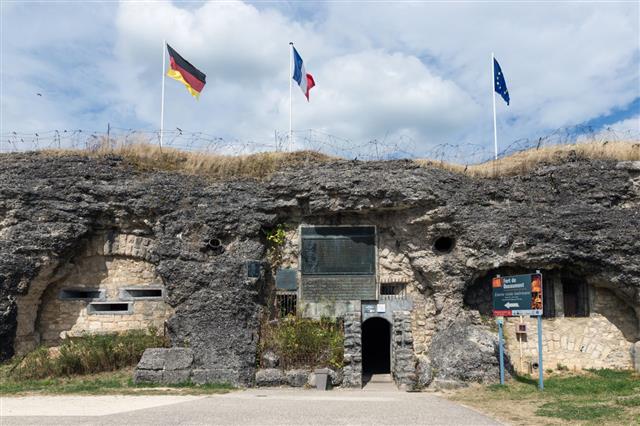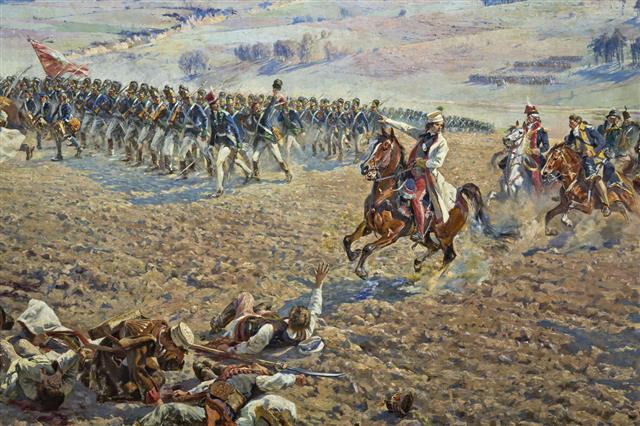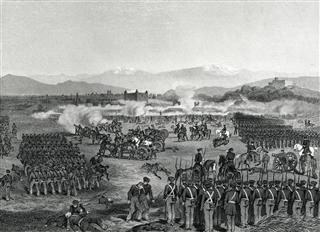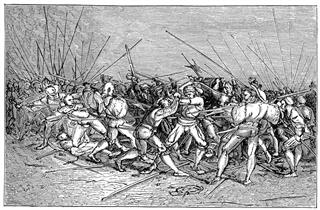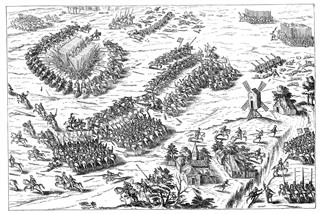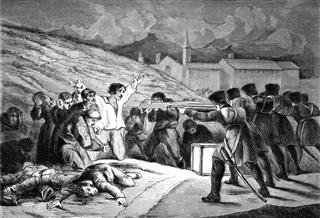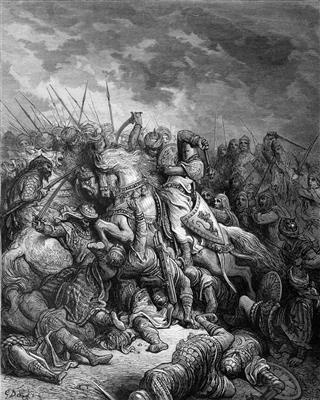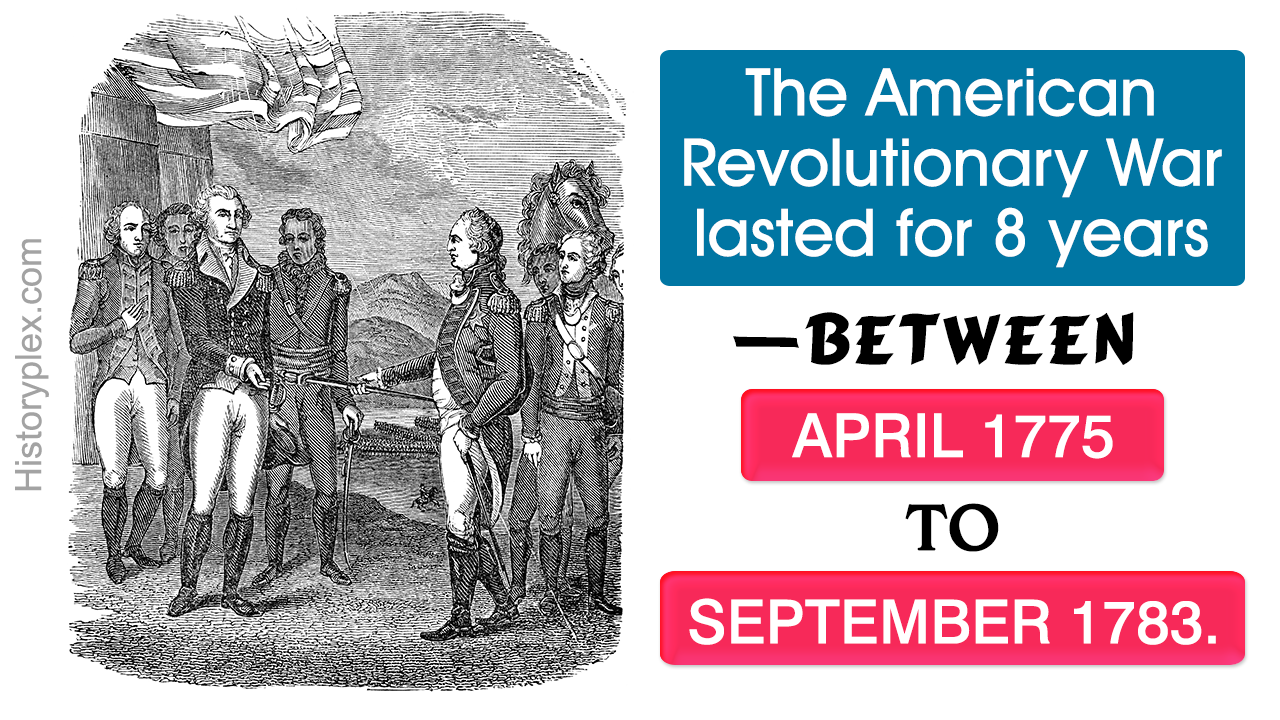
The American Revolutionary War was a rebellion against colonization and unjust laws. The final victory was the result of cumulative display of grit by the Americans in a number of battles and confrontations with the British colonial masters.
The American Civil War included the outcome of various battles that were fought between 1775 and 1783. The strife in American history concluded with the signing of the Treaty of Paris, but not before a heavy loss of life and property. Some of the major battles that were fought during the American Revolutionary War include:
- Battle of Lexington and Concord
- Attack on Quebec
- Battles of New York
- Battle of Valcour Bay
- Battle of Trenton
- Battle of Princeton
- Battle of Bennington
- Battle of Brandywine
- Battle of Germantown
- Battles of Saratoga
- Battle of Monmouth
- Battle of Charleston
- Battle of Camden
- Battle of King Mountain
- Battle of Cowpens
- Battle ofHobkirk’s Hill
- Battle of Eutaw Springs
- Battle of Yorktown
Generally considered to be the first military engagements of the American Revolutionary War, the battles were fought in the towns of Lexington, Concord, Lincoln and Cambridge near Boston on April 19th, 1775. These battles signaled the beginning of hostilities between the United Kingdom and its 13 American colonies. These initial exchanges of about 4000 colonialist with the 800 British forces led 73 casualties for the British and 49 for the colonialist resulting in an unexpected victory for the colonialist. This would mark the beginning of the Revolutionary War, there was to be no turning back now.
The patriots led by Gen. Montgomery launched an assault on Quebec, on 31st December, 1775, and hoped to force the British to defend Canada, which would lead them away from New England. The American assault failed. Six hundred men were captured and 60 died in the attempt to take Quebec. The attack on Canada turned out to be the worst defeat suffered by Americans during the war. This battle turned out to be the first major defeat of the war for the Americans, and that too at a high price. Gen. Montgomery was killed and Benedict Arnold wounded also, 400 soldiers were taken prisoners.
The Battles for New York consisted of three minor battles and was the first exchange between the British and colonial forces after the Declaration of Independence. The first battle at Long Island, on 27th August 1776 saw Gen. Washington being driven out of Long Island. Following the Battle of White Plains, General Howe defeated the retreating Gen. Washington, pushing him further away into New Jersey. Now, Gen. Howe focused his troops on recapturing the entire port of New York including the fort. This resulted in the battle of Fort Washington which eventually marked the complete retreat of the United States army from New York.
Considered to be the first battles fought by the United States Navy and the first naval battle of the American Revolution War resulted in a British victory. On October 11, 1776 at Valcour Bay the American fleet led by Benedict Arnold was destroyed by the British fleet led by Gen. Guy Carleton. Even though this battle resulted in a victory for the British, the resistance put up by the Americans curtailed the British plans for further advancements forcing them to retreat for the winter.
After his defeats and retreat to New Jersey Gen, Washington need to stop a string of British victories with a morale-boosting victory. On 2nd January, 1777 at Trenton New Jersey, Gen. Washington attacked a garrison of German mercenaries, led by a British commander. 150 German mercenaries and their British commander were killed and about 900 captured. Washington and the American forces totally vanquished the British by capturing both soldiers and vital supplies This was the first American victory in the Revolutionary War.
Fresh from their victory at Trenton, the American troops led by Gen. Washington attacked the British army commanded by Gen. Cornwallis at Princeton New Jersey. The Americans surprised the British by attacking just before sunrise on the 3rd of January, 1777. Though the defeat was considered minor by the British, for the Americans this victory at Princeton instilled a belief in them and morale rose in the ranks as more men began to enlist in the army. The consequence of this battle from a strategic-control point of view was that the British had effectively been forced out of Southern New Jersey.
On August 16th, 1777 at Bennington Vermont, patriotic forces of Gen Stark and Warner consisting mainly militiamen from New Hampshire and Massachusetts defeated the British forces of Gen Burgoyne. Thus seriously depleting the British army of men and supplies which indirectly affected the strength of the British army at the subsequent Battle of Saratoga. This victory also galvanized colonial support for the independence movement, and played a role in bringing France on the American side.
At the Battle of Brandywine the British forces led by Gen. Howe defeated the American forces under Gen. Washington on September 11th, 1777. The American forces tried to block the British forces from traveling south, but the resulting conflict led to the retreat of American forces and an unclaimed Philadelphia, the self-proclaimed capital of the United States. Later the British forces would occupy Philadelphia for about a year.
With the British forces occupying Philadelphia, Gen. Washington decided to carry out a four-pronged attack on a small town named Germantown since it was occupied by lesser number of British forces. On October 4th, 1777 a thick fog settled on the battle area resulting in miscommunication between American attack columns. Ensuing confusion and thick fog led to a route by the British army and retreat of American forces.
A key turning point in the Revolutionary War and a major victory for the American forces was at the Battles of Saratoga, a town just north of New York. British Gen. Burgoyne’s initiative to separate the north and south colonies started on a right note with a victory at the Battle of Freeman’s Farm on September 17th, 1777. Later, on October 7th, 1777 when he attacked the American forces at Bemis Heights, he suffered a major blow when the American forces captured a portion of British defenses. The Americans further attacked Burgoyne and cornered him at Saratoga, forcing him to surrender. On 13th October, 1777, one-quarter of the British forces in North America surrendered, thus proving to the other European powers that an American victory was possible and, subsequently, aid provisions began to flow.
The Battle of Monmouth was fought on June 28th, 1778 at Monmouth, New Jersey between Gen. Washington and Gen Clinton of the British forces. This battle is best remembered for a major mix-up among the top leaders of the American forces and the effective retaliation of the British forces. The battle is considered a draw with 300 Americans casualties and 500 British casualties. In the middle of the night General Howe successfully moved his army towards New York.
With the growing might of Gen. Washington in the north, the British forces under Gen. Clinton decided to shift focus on the south by sending troops and naval ships to southern colonies. This resulted in the capture of Savannah in Georgia and later the town of Charleston South Carolina. The British laid siege to the town which lead to the surrender of 5000 men on May 12th, 1780. The British remained in Charleston till they eventually withdrew after the Treaty of Paris.
On August 16th, 1780, the British forces won a decisive victory over the American forces led by Maj. Gen. Gates at the town of Camden in South Carolina. This victory was achieved by the British despite being outnumbered and consolidated its hold on the southern colonies further, after the fall of Charleston. This battle was a complete defeat for the American forces and marked a low in the Revolutionary War.
The battle that was fought between the loyalist forces and patriot forces at Kings Mountain North Carolina on October 7th, 1780. British Major Ferguson and his 1,200 militia were stopped by forces from Virginia and South Carolina atop King’s Mountain. The wooded hill offered the patriots a better chance to get back at the militia. However, the defenders and militia fell in large numbers and was a pivotal moment in the Southern campaign.
General Washington selected General Greene as the Commander of the southern forces. Greene split the army and sent General Morgan to western South Carolina to face British menace. Cornwallis responded via Colonel Tarleton and around 1,000 soldiers. Morgan deployed his soldiers in three lines. The wild American cry was met with bayonet attacks. Just as the British dragoons counter attacked the Americans, Washington’s cavalry appeared. Morgan turned his militia men toward the battle even as the final line of British troops fought and Tarleton thought that they had won the battle. As Morgan ordered his troops to fire, Americans militia approached from the left. The British were faced by Washington’s cavalry from the right and the Battle of Cowpens came down in history as a classic victory.
Sometimes referred to as the Second Battle of Camden, was a tactical victory for the British troops under Francis Rawdon. On April 25th, 1781, Greene led his men along Hobkirk’s Hill’s pine-covered ridge. Lord Rawdon led the British against the Americans. However, fleeing Continental soldiers destroyed the morale and integrity of the defensive line, leading to a British victory. The victory was to be short-lived as a small force of cavalry forced the British to surrender the hill back to the Americans.
General Greene’s army faced that of Colonel Stewart at Eutaw Springs, northwest of Charleston. On September 8th, 1781, the American troops advanced, but floundered when plundering the camp. The counter attack forced an early retreat. Nevertheless, by this time the British were weakened in supplies and men. In the course of the year the Southern strategy of the British to dominate the South, and force the Americans out of the war, fell apart. A year later British forces were confined to Charleston and Savannah.
General Cornwallis arrived in Yorktown and prepared a naval base. General Washington combined with the French forces and surrounded the British army and on October 19th, 1781, forced the British to surrender. Although this was only one-quarter of the British troops in America, the surrender had a devastating effect on the British government, who were now concerned they were losing the war. The Americans captured 8,000 soldiers, 214 pieces of field artillery, and thousands of muskets. The war was effectively over. The Americans had won!!
After the Yorktown defeat and the resignation of Prime Minister Lord North in March 1782, the Revolutionary War in America came to an end. The Treaty of Paris was signed on 3 September, 1783. It was ratified on January 14, 1784, by the Congress of the Confederation. November 25, 1783 saw the last of the British troops leaving New York City.
